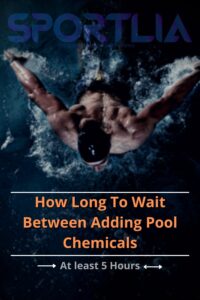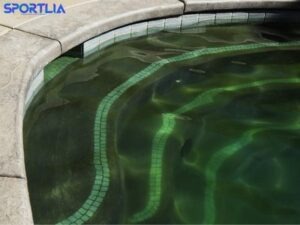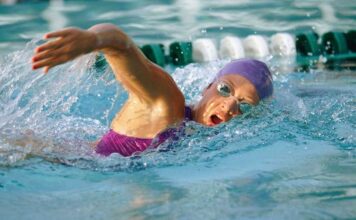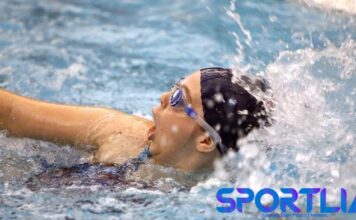
We recommend you wait for at least 5 hours after adding Chlorine into your Pool before you can swim because the more time you give it, the better the Chlorine will dissipate.
However, it also depends on several factors, and the waiting hours can vary.
We all know that Chlorine is necessary for sanitizing pools.
But for how long after putting Chlorine in Pool can you swim?
The answer to your question depends on a number of factors, including the size of the Pool and whether or not you are using any other chemicals besides Chlorine.
However, some general guidelines apply across all pools.
In this post, I’ll provide you with the statistics, data, and a complete guide to swimming after adding Chlorine to your Pool.
Table of Contents
How Long After Adding Chlorine Can You Swim?
In short: You should wait for at least 5 to 6 hours after adding Chlorine to your Pool before you swim.
Many factors influence how long it will take before you can swim after adding Chlorine to the Pool.
Those factors affect the chlorine level present in the water, such as how much water is in the Pool and how acidic your water is.
Generally speaking, it is recommended that pools stand for at least six hours before any swimming activities occur in them.
Because it will allow time for all of the chlorine chemicals to dissipate and the pH balance of your Pool to stabilize.
The quality of your Chlorine also impacts how long it takes for you to be able to swim.
If you use low-quality Chlorine (like bleach), it will take much longer than using a high-quality chlorine form such as gas or tablets.
If you are still unsure how much time your Chlorine will take to dissolve, check the label on the container of the product you are using.
There you might find specific instructions for using the product and the required waiting times before you start swimming once you add it to water.
However, If the information isn’t stated on the label, then contact customer service or the manufacturer for more details.
Because If you use bleach chlorine, tablets, Gas, Hypochlorite (Liquid Bleach), Cal-Hypo, Trichlor, or any other formula, all these have their own time of dissolving.
Despite that, most Chlorine will dissipate within 5 hours, so you might wait for at least 5 hours before you can swim.
However, other factors impact the amount of time you have to wait after adding Chlorine into the water, such as the size of the water surface area and the total volume of water in your swimming pool.
The larger these two factors are, the longer it takes before you can swim into a chlorinated pool.
Factors that affect how long you have to wait After Adding Chlorine In Pool
As you know, many factors influence how long it will take before you can swim after adding Chlorine to the Pool.
1. Size of The Pool

The first thing that affects how long after adding Chlorine you should wait until you can swim is the size of your Pool.
The larger the swimming Pool, the longer it will take for all of the Chlorine to disperse.
So if you have a small pool, waiting about 4 hours may be sufficient, whereas, in a large swimming pool, it could take several hours to disperse fully.
2. Adding Any Other Chemicals Besides Chlorine
Adding another chemical besides Chlorine will also impact your waiting time.
So If you’re using a chemical compound like calcium hypochlorite along with the typical pool chlorine, then it will take longer for the additional chemicals to dissolve into the water and for there to be no residual chemicals left.
If this is the case, it may take up to 8 hours before you can swim.
3. The Amount Of Chlorine Added into Pool’s Water
Thirdly, if you’ve already added sufficient amounts of Chlorine as per your pool size and water level, then it will take less time for all of the Chlorine to dissolve.
However, it would be best if you don’t overdose on Chlorine.
So before you start adding Chlorine into the water, you should know the gallon of water you have in your Pool so that you can add the chemicals as per your water level.
4. Algae In Your Pool

Your waiting time also depends on whether your Pool has any algae or not.
Because if there are algae in your Pool and you want to kill them using Chlorine, you will either have to use the shocking process or add high doses of Chlorine to make the killing effect much more powerful.
In that case, it will take up to 72 hours, even a week, for the Pool to come into normal condition.
Therefore, If there are algae in your water, it may take several hours for the Chlorine to completely dissipate, so have patience.
5. Pool pH Level
The pH of your pool water determines whether or not it is safe for swimming.
If the pH level isn’t just right, it may take several hours for the Chlorine to dissipate, and you shouldn’t swim until the level is safe.
So always check your pool level before adding Chlorine because it will influence the amount of time you have to wait before you start swimming.
You must maintain your swimming pool pH levels within the recommended ranges at any cost.
The recommended pH level is between 7 and 7.6.
I will recommend only adding Chlorine if your pool pH level lies between the recommended level, so your Chlorine will dissipate faster.
However, If your Pool’s pH levels are too low or high, it will take longer for the Chlorine to dissipate into the water.
Also, if your pH levels are in the safe zone and you’ve waited for the right amount of time (about 5 hours), then you should be able to swim in your Pool with no problem.
6. Temperature Of Your Water
If your Pool’s temperature is very low or high, it can slow down the dissolving process.
If your Pool’s water temperature is suitable for swimming, then Chlorine will dissipate as it would normally.
What I mean is that even if you’ve added Chlorine to your Pool within the last few hours, you should be able to swim again after 5 hours.
However, the hot water will aim to dissolve the Chlorine faster than cool water, so the water temperature also affects your chlorine dissipation process [1].
The Benefits of Waiting After Adding Chlorine
There are a lot of benefits to waiting for a long time after adding Chlorine into your swimming pool because the more you wait, the stronger you will be protected from the chlorine consequence.
Here are some of the benefits I gathered, so you can understand that why waiting for a longer time will be worth it;
- Reduces the amount of organic matter in pool water
- Helps to avoid eye irritation from contaminants
- Acts as a disinfecting agent
- Reduces the chance for infection of skin, nail, hair, and eyes
- No itching or burning sensation on the skin
- Chlorine smell is gone when you wait for the right amount of time
- Pool water feels clean and refreshing
- With all its good sides, it’s worth it to wait for a longer time to avoid problems.
Best Time For Adding chlorine to the Pool
The best time for adding Chlorine is the time when you are not going to use your Pool.
However, As far as my experience, I will recommend adding Chlorine in the evening or after swimming.
So your waiting time will pass in the nighttime, so when you wake up, you will be ready for a swim.
However, If it’s a cloudy day without any direct sunlight or strong wind, you can add Chlorine after everything becomes clear – this way, your dirty Pool will be sanitized and clean after using chlorine treatment.
But on hot sunny days where there is high evaporation, it’s better to add Chlorine at that time.
I don’t recommend adding Chlorine just before you go for a swim.
If there isn’t enough time for the pool water disinfection process to take place (for example, when using liquid pool shock), your eyes and skin can sting from solid chemicals in the water.
FAQs – Waiting Between Adding Pool Chemicals
How long does Chlorine take to dissipate completely?
It usually takes up to 4 days for the Chlorine to evaporate completely.
However, The evaporation process depends on your chlorine level and the total volume of your water.
Why can’t I just put in more Chlorine when needed instead of waiting until it dissipates naturally over time?
While you can certainly do this, it is not suitable for your Pool.
Chlorine only works to sanitize the water when it’s in its free form – chlorine gas or hypochlorous acid.
The “free” part of the molecule attaches to other contaminants present in your Pool and then turns into a less active state once it has done its job.
If you add too much, the Chlorine will turn into an inactive form of itself before it’s had time to do what it needs to – effectively sanitize your Pool.
What is the proper chlorine level in a pool?
The proper chlorine level in the Pool is between 1.0 to 4.0 ppm (parts per million).
A healthy pool will have no more than 4.0 ppm of Chlorine in the water, and experts recommend keeping chlorine levels at 1 to 4.0 ppm (parts per million) to avoid it becoming too harsh on the eyes and skin.
How soon after putting in Chlorine can I swim?
Most people can swim after waiting for 4 to 5 hours after following a standard dose of Chlorine.
However, some factors will determine how quickly your pool water reaches an acceptable level of Chlorine, and these include:
– The Pool’s size – Smaller pools take up less space than large ones and thus dissipate Chlorine faster.
– How much you add at once – If you add too little or too much Chlorine at once, it will take longer to dissipate than if you use the standard dose.
– How much Chlorine is already in your Pool – If there’s a lot of free Chlorine in your water when you add more, then the new molecule won’t be able to attach itself and thus will sit uselessly until enough time passes for it to dissipate.
What else can I do besides adding Chlorine?
There are several things you can do to keep your water clean.
First, make sure that you’re maintaining proper pH levels – this will help the chlorine work more effectively and not turn into an inactive state too quickly.
You can also reduce the amount of free Chlorine already in your Pool by adding scum away or other chemicals.
While these won’t remove existing Chlorine in the water, they will prevent more from being created.
Furthermore, you can also add a clarifier to your Pool which helps break up oils and other contaminants floating on top of or stuck between tiles so that free Chlorine has something else it can attach itself to when you add additional amounts.
What about saltwater pools?

Saltwater pools tend to dissipate Chlorine at a slower rate than usual, so you will need to add more Chlorine frequently – especially in the summer when your Pool is open and exposed to sunlight for hours on end.
Not only does this increase how quickly it becomes less effective, but it also increases the likelihood that you will develop a chlorine allergy – this is where your body becomes overly sensitive to chlorine and experiences irritation when exposed.
Conclusion:
I hope now you will understand that How long after putting Chlorine in the Pool can you swim?
As you see, the amount of time you have to wait will depend on various factors.
No one solution fits all!
However, generally, most Chlorine will dissipate within 5 hours so that you can swim after that.
It is because many factors can affect how quickly Chlorine will dissipate in the water.
Also, other chemicals besides Chlorine can have an impact on the time frame.
For example, if you use bromine or something else for sanitizing purposes, it’s essential to know what type of chemical you are using.
All these variables make determining a specific timeframe difficult but washing out any residual chemicals after adding more often than not decreases the amount of time needed until it’s safe to swim again.
Ultimately, waiting for 24-48 hours is a safe bet if you consider all the factors.
At last, if the pH levels are safe and you’ve waited for the proper amount of time after adding Chlorine, you should be able to swim with no problems.
But before you swim, you should check the chlorine level in your Pool to stay on the safe side.
Also Read: How To Protect Dyed Hair From Chlorine





